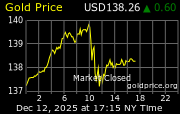Overnight Gold prices rallied as the dollar weakened against the euro on easing risk aversion
 Overnight Gold prices rallied as the dollar weakened against the euro on easing risk aversion. This increased appetite for risk occurred despite S&P’s downgrade of the European Financial Stability Facility, although given the downgrades of nine Eurozone countries over the weekend, this was hardly surprising, explaining the lack of negative reaction.
Overnight Gold prices rallied as the dollar weakened against the euro on easing risk aversion. This increased appetite for risk occurred despite S&P’s downgrade of the European Financial Stability Facility, although given the downgrades of nine Eurozone countries over the weekend, this was hardly surprising, explaining the lack of negative reaction.Further impetus came from Chinese GDP figures which, while better than expected, showed Q4:11 growth had slowed to 8.9% y/y (from 9.1% y/y in the previous quarter), bolstering hopes of further monetary easing. While the PBOC might contemplate lowering the reserve requirement, we have found that such an action has a relatively benign long-term effect on commodity prices. More aggressive monetary easing measures such as raising the target for new loans and interest rate cuts have the most marked effect on commodity prices (though after a considerable lag in the case of interest rate changes).
However, we feel it is still some time before the PBOC resorts to using these policy instruments.
Gold and silver are the underperformers today in the precious metals complex, maybe as a result of amendments to India’s levy on imports of these metals. As of today, the new import duties are 2% and 6% per ounce on gold and silver respectively. Previously, a flat rate of 300 rupees per 10g for gold (effectively $18.29/oz at 51 rupees per dollar) and 1500 rupees per kilo
(effectively 91c/oz). The new rates equate to roughly around $33/oz and $1.83/oz at current prices for gold and silver respectively—so this represents a significant increase in these duties.
Gold support is at $1,647 and $1,631. Resistance is $1,663 and $1,678.














0 comments:
Post a Comment